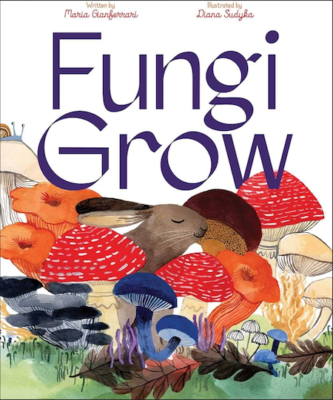
S&S/Beach Lane | 978-1665903653
I’ve admired Maria Gianferrari‘s work for years, and 2023 has been an especially busy time for her as this year Maria released 5 new books! Today, I am thrilled to share her recently published, FUNGI GROW, illustrated by Diana Sudyka. This ode to fungi is a delight to read aloud as well as a must-have for all home and school libraries. The text is lyrical and informative and the art is truly stunning, some of Diana Sudyka’s finest work. Writers will find FUNGI GROW is the perfect mentor text for the best science-based picture book nonfiction being created today.
Here’s the publisher’s description:
Above ground, below ground, all around, fungi grow. They root and fruit and twist and twine everywhere on earth. Some are edible, some are medicinal, some are even poisonous. Step into this book and discover the amazing array of mushrooms and see how they multiply. Learn how fungi heal and help humans. Explore the incredible underground fungal network that helps forests thrive. And so much more!
As soon as I laid eyes on FUNGI GROW, I knew I wanted to interview Maria about its creation. I’m so glad she said YES!
🍄🍄🍄
DIANNE: Thanks for joining us on ReaderKidZ, Maria. I’ve been a fan of your books for ages, and I’m so excited to talk to you about one of your newest, FUNGI GROW! You mentioned in an interview with Andrea Wang on Picture Book Builders, that the inspiration for Fungi Grow began while researching your book, Be a Tree!
MARIA: Thanks for having me on ReaderKidZ, and likewise, Dianne! It was lovely to finally have met you at NCTE, and of course, we share both a love of words and a beloved illustrator in Felicita Sala. [DW: Indeed. Felicita is the best!]
DIANNE: You mention in your Picture Book Builders interview that your “discovery draft” began with a focus on mushrooms, but eventually led you to the underground world of fungi. I’ve heard novelists use the term discovery draft, but I’m not sure I’ve ever heard an early draft of a picture book referred to in exactly that way, and I’m curious. Do you write a full draft with a certain focus in mind and later decide that you want to zoom in on a particular aspect of your original idea, or –in the case of Fungi Grow — open up the idea to include more? Can you share a little about your process?
MARIA: Every project is a little bit different. Sometimes, though rarely, things come out in nearly full form—I hear the voice and the sentences form in my head, and I am in the zone. The words flow. That was the case for Be a Tree! as well as another picture book, Being a Dog: A Tail of Mindfulness. For those, the editing process was only a bit of paring and re-arranging. It’s so nice when those “gifts” from the universe happen (or with the latter, I think of it as a gift from my late and very beloved dog, Becca). But alas, most often, it’s a process of finding the right voice and tone and structure through trial and error and experimentation—that’s why I think of it as a discovery process.
Be a Tree! led me to the world of mycorrhizal fungi—the kind that partner with trees and other plants, and the magic of mycelium, the roots of fungi. The first draft I wrote, called Marvelous Mushrooms, was a direct celebration of mushrooms themselves. It sparked the interest of editor Andrea Welch who requested a revision. After a wonderful conversation, we both agreed that it wasn’t quite there yet. So that’s when the “discovery” aspect happened—I had to try a lot of different formats to figure out how and what I most wanted to say. Sometimes that involves taking on different structures to see how things take shape, the way a sculptor chisels and hones. We do that with our words. Once I came up with the “fungi grow” refrain, and decided to take a circular life cycle approach, beginning and ending with spores, then things came together.
DIANNE: Ah, yes! That makes sense! Our writing processes sound very similar in that sometimes an idea comes fully formed, and other times, it’s all about play and experimentation with the form and shape.
Fungi Grow reads like a poem in free-verse and your use of language (alliteration, assonance, onomatopoeia, rhyme and more) makes the read-aloud experience rich and enjoyable. Do you have any favorite lines? Or a sentence that popped out and you immediately knew it was perfect?
MARIA: Thanks, Dianne. It’s magical when that happens! This section sprouted in full form. I love Diana’s art—so lush and lovely.
“Mushrooms sprout.
Parasols pop out.
Mushrooms fan,
arc,
Spread their skirts.”
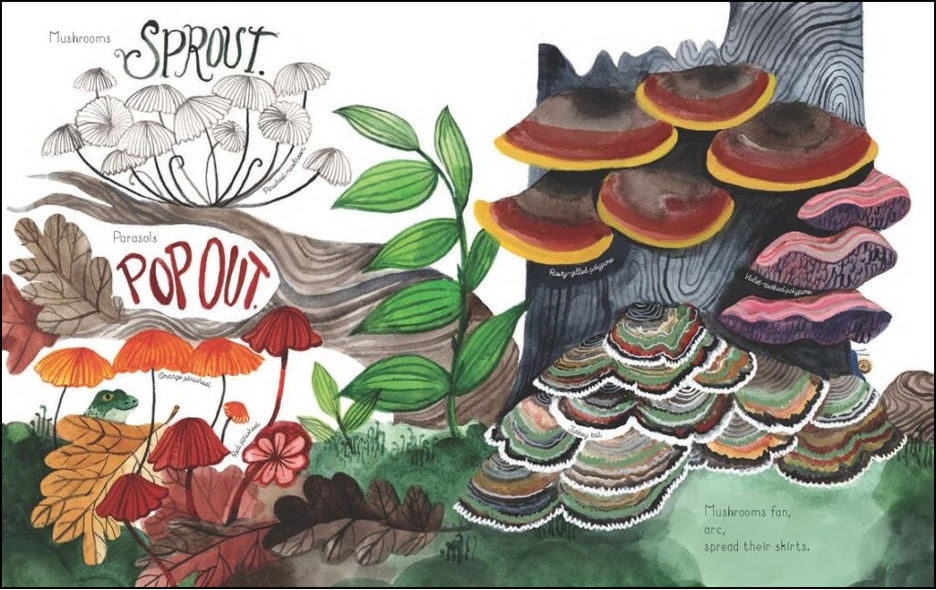
© Text by Maria Gianferrari, illustration by Diana Sudyka
DIANNE: There’s a journey in this book – from spores to mycelium roots to fruit – the mushrooms that we’ve all seen sprouting in the woods or on our lawns. Their story could have been told in any number of ways, but you chose to write a lyrical ode to all things fungi. I bet it was challenging, but also fun! What was that process like?
MARIA: One thing I really wanted to share with readers is the idea of this hidden world beneath our feet—miles and miles of mycelium we only know is present when mushrooms form into fruit (unless we turn over old branches, or dig in the leaf litter). The kingdom of fungi is so fascinating, and there is so much out there yet to be discovered!
So, I began with spores, and the different ways that they are dispersed—through gills, teeth or pores, via wind, or water, or creatures, and the amazing ways that mushrooms have found ways to reproduce. I adore the way that Diana hand-lettered the onomatopoeic words and incorporated them so they blend with the art so seamlessly—it’s brilliant (and beautiful). Once I had this idea in mind, the life cycle structure emerged—starting with spores, they root, form hyphae, stretch and spread into mycelium. I really wanted to showcase the magic that’s happening underground. The next natural step was to focus on the various mushroom types, mycorrhizal, saprotrophic (decomposers) on to the explosion of the fruiting bodies of mushrooms in all their beauty and glory, and then back into the specific ways they work their wonders.
DIANNE: Can you talk about the embedded STEM information you include on many pages? Did you know from early on which types of fungi and related information you wanted to include? I’m also curious about any collaboration you might have had with the editor and illustrator as the sketches came in and the layout of text and art and “sidebars” were discussed?
© Text by Maria Gianferrari, illustration by Diana Sudyka
MARIA: There were some really STEM-amazing things that I knew I would definitely include right from the start like hulk bugs—who knew fungi could thrive in radioactive conditions? Plus, I love the humorous name.
Zombie ant fungus is way too cool not to have included. It basically invades an ant’s brain, forcing it to leave its nest and lock its jaw on a leaf. The ant then dies and a mushroom pops out of its head and rains spores on the ant colony below where it infects event more ants! Cordyceps really became popularized last fall in the series, by The Last of Us. But this fungus’ parasitic reproductive strategy evolved over millions of years and is specific to ants. Mycologists say that it’s unlikely to infect humans, but if it did, that too would probably take millions of years.
Mushrooms are sustainable and master recyclers—their mycoremediation properties are astounding: they can digest powerful pollutants, such as petroleum, chemical waste, and even heavy metals like mercury, so I knew their superpowers had to be celebrated in the book.
I love weaving in scientific language which can also be quite poetic; STEM concepts and poetry truly go hand-in-hand, like the way that hyphae release enzymes—they “spit/from hyphal tips,” a process of making new soil as they unmake whatever it is that’s being digested. Another example is this process called “puffing,” the wondrous way cottony rot fungus actually makes its own wind to spread its spores even farther. How cool is that?
Having a dual text can appeal to readers of different ages. A main text that is spare, poetic and lyrical can be read on its own to the younger set, separate from the more detailed STEM-ish sidebars which can appeal to older kids (and adults). When I read it at events, I begin by just reading the main text, and then I go back and re-read it with the sidebars. In that way we can delve into the science more and see the art anew too.
We collaborated and did our best to get the science right—we wanted to be as mycologically accurate as we possibly could. Some of the sections focused on specific mushrooms/fungi, like the shaggy ink cap which is so strong it can sprout through cement, or stinkhorn mushrooms that smell like rotten meat to attract flies, while others, particularly in the middle of the book, were left wide open for Diana to work her magical creative powers and visual artistry.
For example, this was the only text for this spread:
“Mushrooms bewitch, beguile and multiply.”
And from those mere words, Diana created this stunning spread featuring a wide variety of bright and beautiful mushrooms.
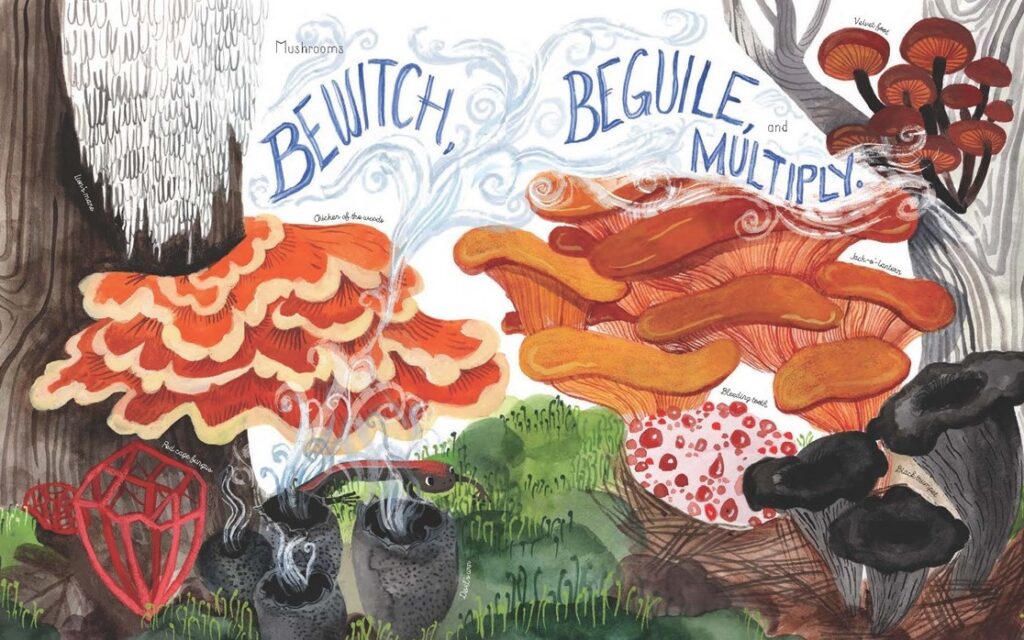
© Text by Maria Gianferrari, illustration by Diana Sudyka
And Diana is such a nature lover—I love how she “peoples” the book with all manner of small creatures from snails and salamanders, to moths and millipedes, bees and butterflies and an abundance of toads. That would be another fun thing to do with littles—ask them to find the hidden creatures in the book.
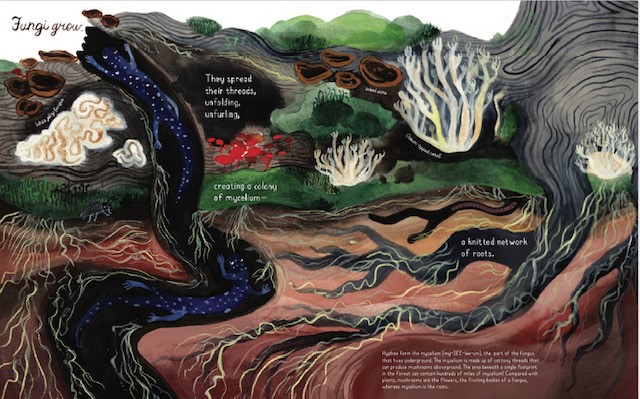
© Text by Maria Gianferrari, illustration by Diana Sudyka
DIANNE: Thanks for walking readers through the genesis and development of your truly beautiful picture book.
You’ve had a busy year, with five new books out in 2023. Congrats! What’s up next?
MARIA: I’m looking forward to a quiet 2024—I will not have any books releasing, but I can continue to share this year’s releases in ways that will be less hectic, with meaningful tie-ins. My next book, a fiction picture book called Rain and the Reading Horse, with gorgeous art by Hannah Salyer, will be published in spring 2025 from Clarion Books. Hannah has a magnificent new picture book this year called Ancestory, that’s garnering a lot of well-deserved accolades.
As a picture book author, I feel so grateful and fortunate to work with such amazing artists and illustrators and visionary editors! It’s always such a delight to get those first sketches—to see the words brought to life in the art.
Stay tuned for a couple of nature-y book announcements to come :-).And thank you for featuring our Fungi Grow, Dianne!
DIANNE: Thank YOU, Maria. I can’t wait to hear more about your upcoming books. And, I hope while we’re waiting, readers will check out your website, where they can find out more about both your 2023 books and ALL the books that came before.
🍄🍄🍄
Check out this “Homemade City” craft activity to accompany FUNGI GROW!
Read this interview with Maria on Picture Book Builders!








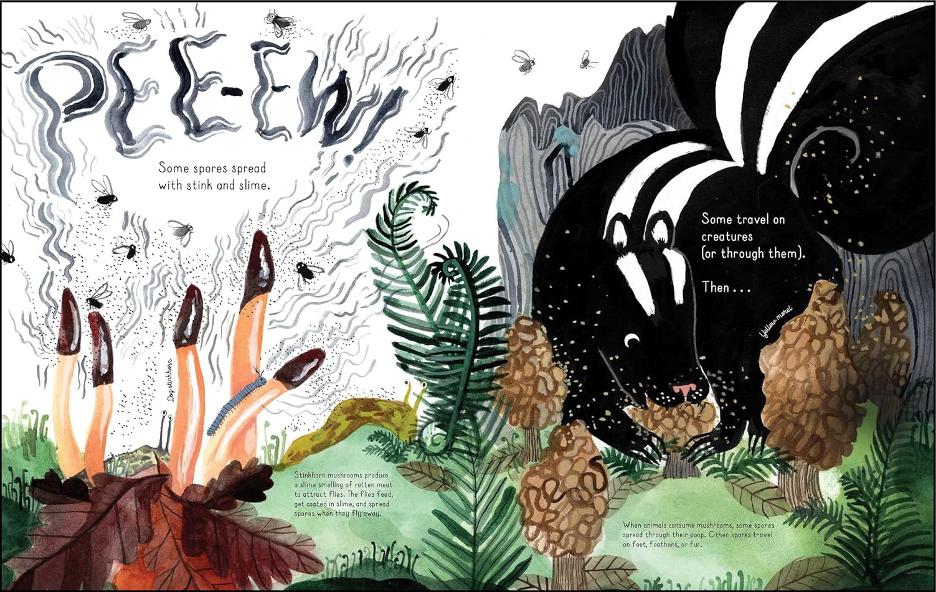



Such a lovely post, Dianne! Thank you so much for sharing our book, and for the very kind words!
Hooray for fungi & STEM books for kids!
~Maria
Thank YOU, Maria, for taking the time to answer ALL of my questions! Lol!